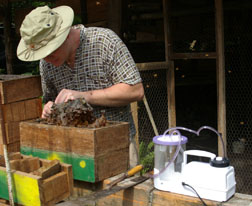
|
How do we collect and store the honey?
We use the modern rational bee hive design as developed
by Noguiera-Neto in Brazil, a design that allows us to harvest honey
under very hygienic conditions. We use a medical aspirator (AspiraMax
MA-520) imported from Brazil to efficiently gather honey from individual
honey pots. All of our honey gathering equipment and bottles are boiled
for sanitation before each use. The honey is then gathered from the Melipona colony
and bottled directly. To avoid fermentation of the honey, we pasteurize
the honey by heating it up to 72° C for 15 seconds, as recommended by
Noguiera-Neto. The honey should be kept dark and at room temperature,
although if necessary to store the honey for an extended period of time,
refrigeration may be used to prevent fermentation. For extraction of
honey from Tetragonisca hives it is necessary to remove all of the honey pots from the hive and manually extract the honey. The wax produced by Tetragonisca for their honey pots is so delicate that the aspirator collapses the pots when used. Due to this our honey from Tetragonisca may contain tiny fragments of the honey pots.
|
|
|
 |
How to consume the honey you just purchased?
We recommend to use our stingless bee honey against the
common cold in a mix of two tablespoons of honey (10 ml) and half a
tablespoon of fresh lime (2.5 ml). It is also recommended to add a
little garlic if you are coughing. Stingless bee honey is also great in
fruit salads; adding it to a bowl full of e.g. banana, pineapple, apple,
mangos, grapes, the juice of two oranges, and finally three-four
tablespoons (15-20 ml) of stingless bee honey. Fruit flavored yogurt can
be added. Of course, the honey can also be used in place of honey bee
honey or sugar to add a more exotic flavor, but keep in mind, that honey
from stingless bees is a little more runny than what you usually
experience with honey bee honey.
|
|
|
 |
Different varieties of stingless bee honey
We keep a range of stingless bees for study. They all
have their unique and characteristic honey. Generally we recommend the
consumption of honey only from the genera Melipona and Tetragonisca,
as well as a few others that we do not sell at the moment. The quantity
of honey produced is low compared to honey bees. After a full year we
expect to harvest 4-500 ml from a good hive of Melipona. We leave
all of the pollen pots untouched for the bees to use and also leave
some of the honey pots in the hive for the bee to survive on. The
production in Tetragonisca hives is minor, and we extract less than 100 ml from their hives during a year.
|
|
|
 |
Where did your honey come from?
Our colonies are kept in different parts around the
city of Tarapoto, San Martin, Peru. Our bees will here visit tall trees
in the secondary rainforest along the River Shilcayo or River Cumbaza.
They will occasionally encounter a few monkeys or a lone toucan in the
trees, while colorful poison-arrow frogs (Dendrobates) sing from
the bank of the river. We are not certain how many different trees have
been visited for your honey, but guarantee that the honey is completely
authentic and not altered or modified by additives or artificial feeding
during the honey production. This guarantees a rich and unique flavor
to your honey. Supplemental sugar is provided to strengthen the colonies
only when we are installing colonies into new hives following
reproduction, and thus prevents us from loosing a very valuable genetic
resource from our management program.
|
|
|
 |
Rainforest conservation and stingless bees
The stingless bees depend on the rainforest to succeed. Unlike honey bees (Apis mellifera)
they do not adapt to low diversity crop systems and will disappear if
the rainforest disappear. Therefore the promotion of stingless bees is a
very important tool to educate people living in the rainforests about
the importance of their surrounding forest. Honey production by native
stingless bees is also an ecologically very sound and cheap method to
generate a sustainable livelihood in the Amazon rainforest. Production
of stingless bee honey provides the farmer with an economic alternative
to logging and encourage the conservation of trees as nectar and pollen
sources. By developing stingless bee honey programs, we hope to raise
the living standard for otherwise marginalized people and contribute to
their awareness in conservation of the rain forest and all of its
inhabitants.
|
|
|
 |
We are a legally registered Peruvian NGO ("Asociación Civil Melipona").
Since 2002 we have kept and studied stingless bees. Our mission is to
promote the keeping of stingless bees throughout the Amazon region in an
aim to teach people about conservation and the importance of
eco-systems as an sustainable alternative, with the utilization of
non-timber forest products like honey from stingless bees. We are still
in a pilot-phase developing techniques for keeping stingless bees and
pursuing other conservation goals. Our background range from
professional entomologist with Ph.D., agronomists, and Peruvian farmers,
all united by the curiosity and love for the nature and the native
bees.
http://www.melipona.org
|







No comments:
Post a Comment